THM Dissecting PE Headers
Task 1 - Introduction
In Windows, .exe files stands for executable files. It contains code that can be executed by the machine. An executable file is also called a portable Executable (PE) file. A PE file is a Common object File Format (COFF) data structure. The COFF consists in Windows of PE files and DLL and in Linux, it is shared objects and ELF files.
Learning Objectives
In this room, we’ll review the following:
- Understanding the different headers in a PE file
- Learning how to read PE headers
- Identify packed executables
- Use the information from PE headers to analyze malware
Task 2 - Overview of PE Headers
A PE executable is like other type of data, a combination of bits and when looking into it using an Hex editor, we can see a bunch of random hex chars. These are instructions for Windows to execute the file.
In this room, we will use wxHexEditor and pe-tree to visualize better a PE header structure.
The most impotrant headers are:
- IMAGE_DOS_HEADER
- IMAGE_NT_HEADERS
- FILE_HEADER
- OPTIONAL_HEADER
- IMAGE_SECTION_HEADER
- IMAGE_IMPORT_DESCRIPTOR
These headers are the data type STRUCT in C, which is a user-defined data type that combines different types of data elements into a single variable. Thus, to understand each header, we need to go through documentation.
Question
What data type are the PE headers
Answer: STRUCT
Task 3 - IMAGE_DOS_HEADER and DOS_STUB
We are using pe-tree with the given sample redline.
IMAGE_DOS_HEADER
The IMAGE_DOS_HEADER consists of the first 64 bytes of the PE file. In pe tree, the values are shown in little endian format; the least significant bytes are shown first (the ones in right).
LE: 0x1020304050 BE: Ox5040302010
The first thing we can understand is MZ, which stands for Mark Zbikowski (one of the architect of this format), and it is the character identifying the PE format. This signature is also called e_magic and has a value of 0x5a4d.
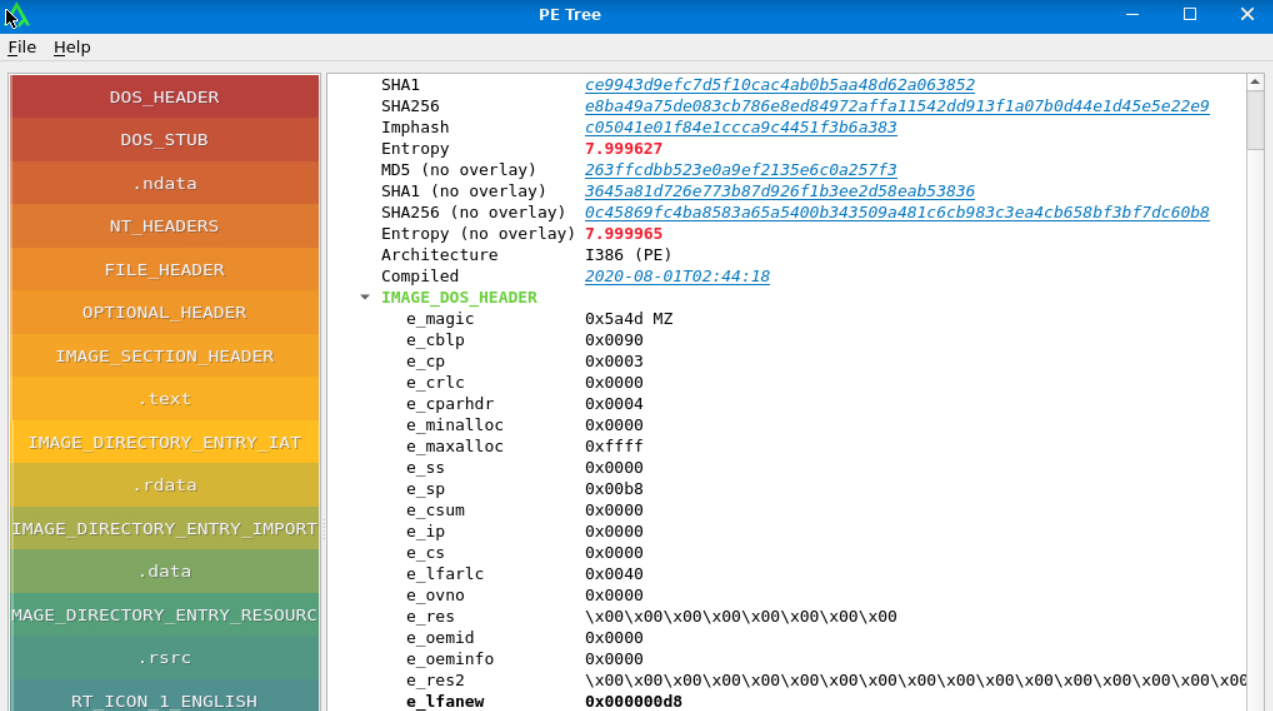
The last value called e_lfanew, has a value of 0x000000d8 and denotes the address where IMAGE_NT_HEADERS start.
DOS_STUB
The DOS_STUB is just after the IMAGE_DOS_HEADER and is mainly used to contain the piece of code if the PE file is incompatible with the system.

Questions
How many bytes are present in the IMAGE_DOS_HEADER?
Answer: 64
What does MZ stand for?
Answer: Mark Zbikowski
In what variable of the IMAGE_DOS_HEADER is the address of IMAGE_NT_HEADERS saved?
Answer: e_lfanew
In the attached VM, open the PE file Desktop/Samples/zmsuz3pinwl in pe-tree. What is the address of IMAGE_NT_HEADERS for this PE file?
Answer: 0x000000f8
Task 4 - IMAGE_NT_HEADERS
Here, we will focus on the different parts of IMAGE_NT_HEADERS, containing vital information related to the PE file.
NT_HEADERS
NT_HEADERS consist of:
- Signature: Contains
PEkeyword in ASCII - FILE_HEADER
- OPTIONAL_HEADER
The Signature consists of marking the start of NT_HEADERS.
FILE_HEADER
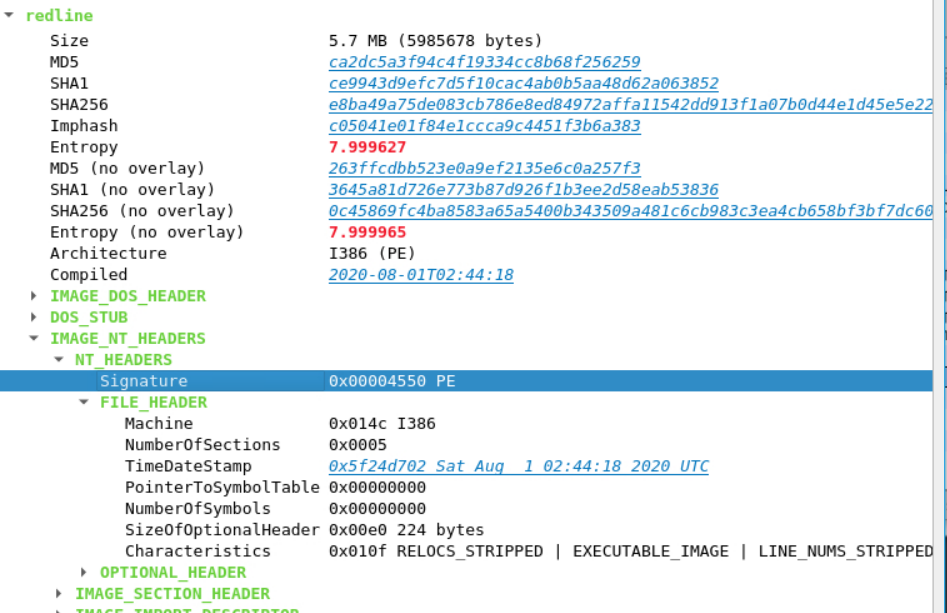
The FILE_HEADER gives some vital information like:
- Machine: Type of architecture the PE file is written.
i386is for 32-bit architecture. - NumberOfSections: A PE file contains section where code, variables and other ressources are stored. It mentions how many the PE file has.
- TimeDateStamp: Time and date of binary compilation
- PointerToSymbolTable and NumberOfSymbols: Generally not related to PE files and are there due to COFF file headers.
- SizeOfOptionalHeader: Size of the optional header
- Charactristics: Tells us that the PE file is an executable image, has stripped relocation information, line numbers, and local symbol information.
For characteristics, these means that the executable is not position-independent and must be loaded at a specific base address, the PE file does not contain detailed debugging data and debugging symbols are removed, making it harder to debug or analyze the executable.
These are located here in the hex view with the value 0x0f01.

Questions
In the attached VM, there is a file Desktop\Samples\zmsuz3pinwl. Open this file in pe-tree. Is this PE file compiled for a 32-bit machine or a 64-bit machine?
According to pe-tree, Machine 0x014c I386.
Answer: 32-bit machine
What is the TimeDateStamp of this file?
Answer: 0x62289d45 Wed Mar 9 12:27:49 2022 UTC
Task 5 - OPTIONAL_HEADER
The OPTIONAL_HEADER is also a part of the NT_HEADERS and contains some of the most important information.

The most important fields are:
- Magic: Tells whether the PE file is a 32-bit (
0x010B) or a 64-bit appliaction (0x020B). - AddressOfEntryPoint: Address where Windows will begin execution. This is an offset relative (RVA - Relative Virtual Address) of the base address contained into ImageBase.
- BaseOfCode and BaseOfData: Relative addresses of code and data sections.
- ImageBase: Preferred loading address of the PE in the memory. Generally, the value is
0x00400000but can sometimes be changed and relative addresses are relocated following the new ImageBase. - Subsystem: Represent a value for Windows Native, GUI, CLI or other ones.
- DataDirectory: Contains import and export information of the PE file. These locate the RVA of the needed sections.
Questions
Which variable from the OPTIONAL_HEADER indicates whether the file is a 32-bit or a 64-bit application?
Answer: Magic
What Magic value indicates that the file is a 64-bit application?
Answer: 0x020B
What is the subsystem of the file Desktop\Samples\zmsuz3pinwl?
Answer: 0x0003 WINDOWS_CUI
Task 6 - IMAGE_SECTION_HEADER
Sections in a PE file contains data like code, icons, images, GUI elements… and information about these are stored into the IMAGE_SECTION_HEADER.
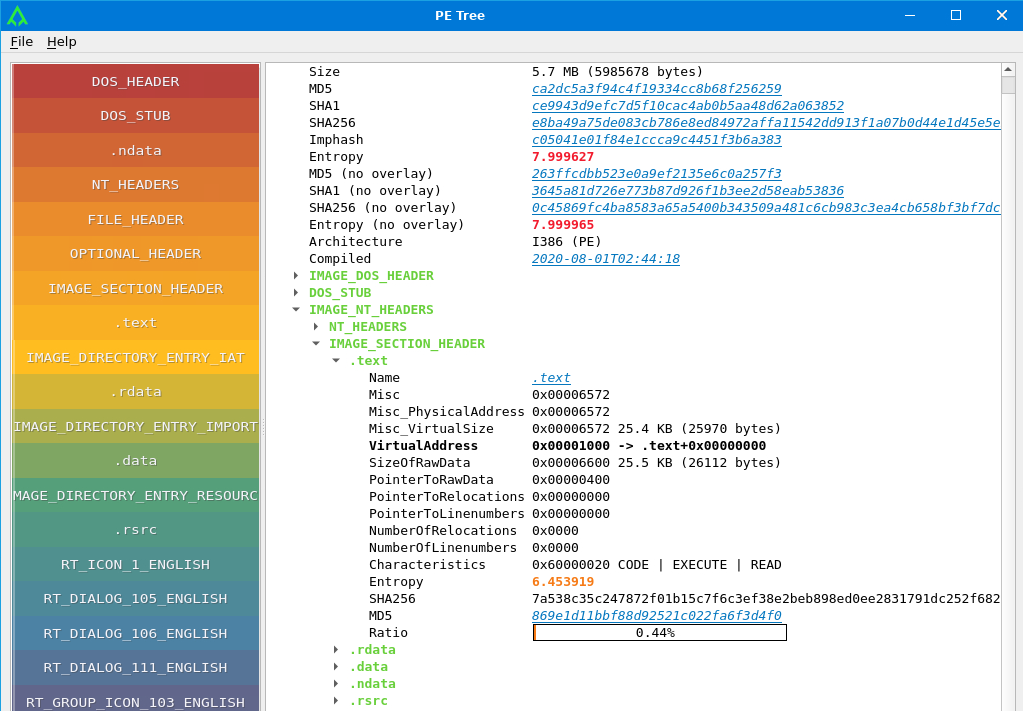
In this header, we can find different sections named .text, .rdata, .data, .ndata and .rsrc.
- .text: Contains the executable code. The Characteristics for this section include CODE, EXECUTE and READ, meaning that this section contains executable code, which can be read but can’t be written to.
- .data: Contains initialized data of the application. The Characteristics are READ/WRITE.
- .rdata/.idata: Contains import information to import functions or data from other files.
- .ndata: Contains uninitialized data.
- .reloc: Contains relocation information of the PE.
- .rsrc: Contains icons, images or other ressources required for UI.
Into each sections, we can retrieve information like:
- VirtualAddress: Section’s RVA.
- VirtualSize: Section’s size once loaded into memory.
- SizeOfRawData: Section’s size as stored on the disk before loaded in memory.
- Characteristics: Permissions of the section.
Questions
How many sections does the file Desktop\Samples\zmsuz3pinwl have?
Answer: 7
What are the characteristics of the .rsrc section of the file Desktop\Samples\zmsuz3pinwl
Answer: 0xe0000040 INITIALIZED_DATA | EXECUTE | READ | WRITE
Task 7 - IMAGE_IMPORT_DESCRIPTOR
The IMAGE_IMPORT_DESCRIPTOR structure contains information about the different Windows APIs needed to be loaded when the application in executed.
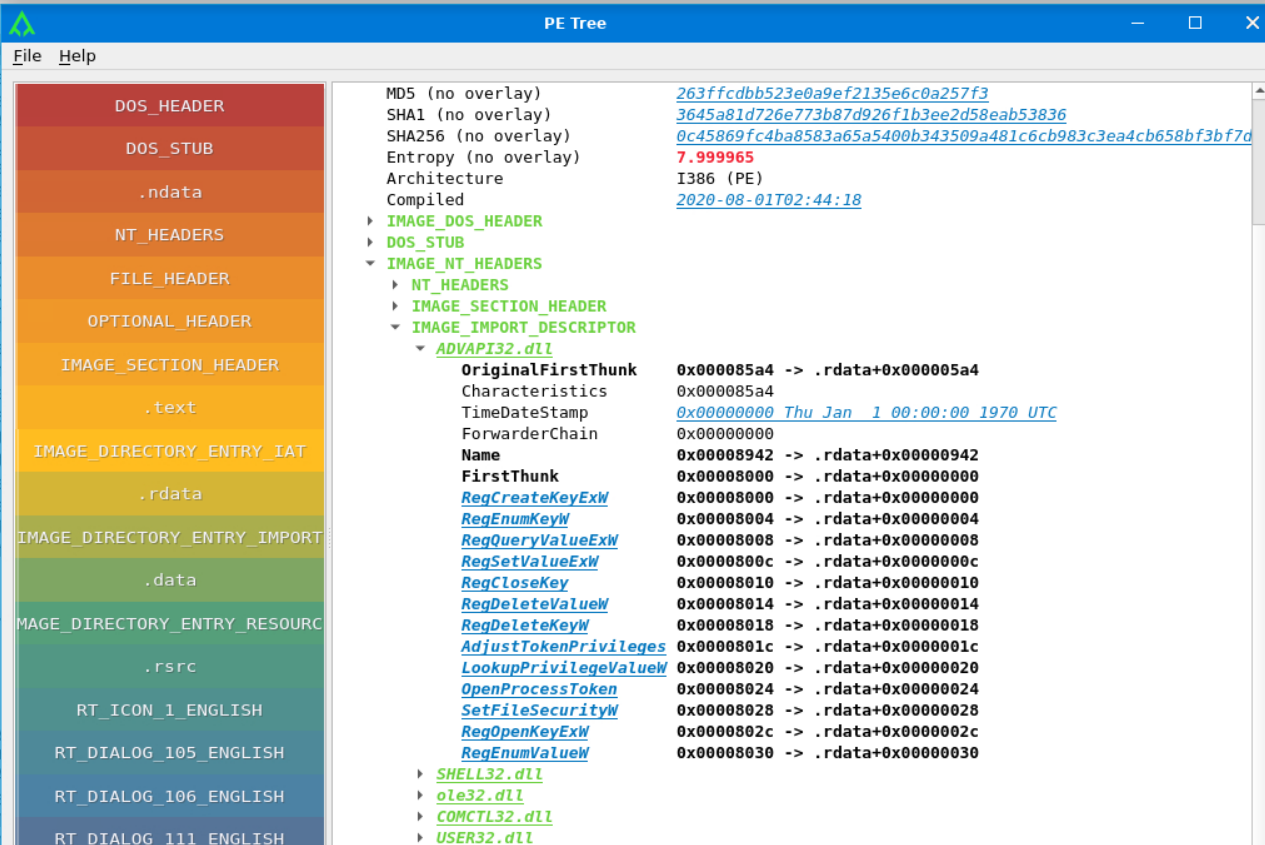
As we can see, this PE imports functions from ADVAPI32.dll, SHELL32.dll, ole32.dll, COMCTL32.dll, and USER32.dll. OriginalFirstThunk and FirstThunk values are used by the OS to build the Import Address Table (IAT) of the PE file.
- OriginalFirstThunk is an array of pointers to IMAGE_THUNK_DATA structures containing references to imported function names or ordinals, used by the OS loader during dynamic linking of a PE file.
- FirstThunk is an array of pointers within the Import Descriptor table of a PE file, initially populated with the same values as
OriginalFirstThunkand later updated with resolved function addresses during dynamic linking. - The Import Address Table (IAT) is a data structure used by the operating system to store the resolved addresses of imported functions from external DLLs, facilitating dynamic linking in a PE file.
By studying imports of the PE file, we can learn a lot about what activities it might perform.
Questions
The PE file Desktop\Samples\redline imports the function CreateWindowExW. From which dll file does it import this function?
Answer: USER32.dll
Task 8 - Packing and Identifying packed executables
Because PE file’s information can be easily read, packers obfuscate the data in a PE file in a way that it can’t be read without unpacking it. The unpacking process is ran when the PE file is executed. This is done in order to prevent program’s static reverse engineering.
From Section Headers
In previous task, we have seen that sections are commonly named .text, .data and .rsrc. When looking at the file zmsuz3pinwl, we can see there is some unconventional names.
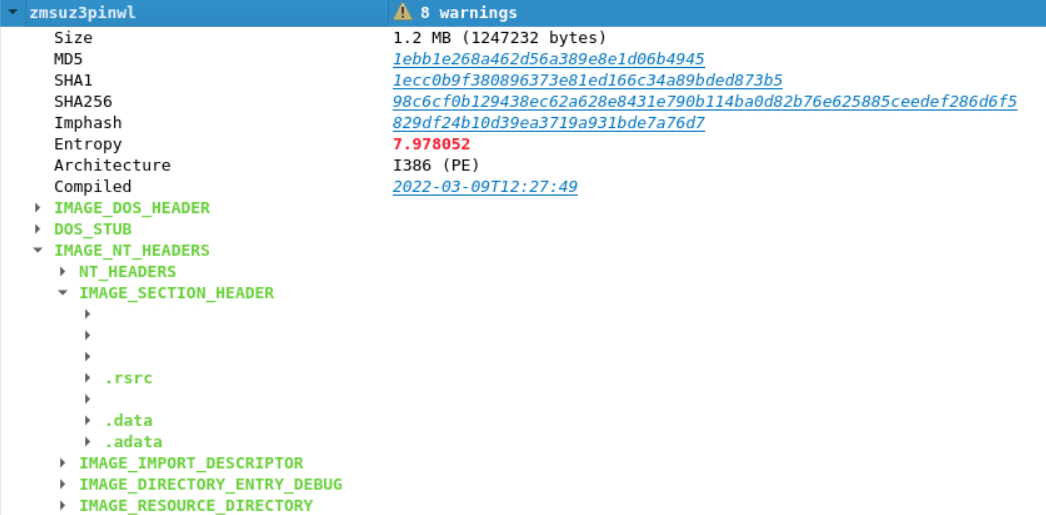
Using pecheck:
...
entropy: 7.999788 (Min=0.0, Max=8.0)
entropy: 7.961048 (Min=0.0, Max=8.0)
entropy: 7.554513 (Min=0.0, Max=8.0)
.rsrc entropy: 6.938747 (Min=0.0, Max=8.0)
entropy: 0.000000 (Min=0.0, Max=8.0)
.data entropy: 7.866646 (Min=0.0, Max=8.0)
.adata entropy: 0.000000 (Min=0.0, Max=8.0)
...
[IMAGE_SECTION_HEADER]
0x1F0 0x0 Name:
0x1F8 0x8 Misc: 0x3F4000
0x1F8 0x8 Misc_PhysicalAddress: 0x3F4000
0x1F8 0x8 Misc_VirtualSize: 0x3F4000
0x1FC 0xC VirtualAddress: 0x1000
0x200 0x10 SizeOfRawData: 0xD3400
When checking the Entropy of .data and three of the four unnamed section, it is high, approaching 8. This means there is a high level in randomness in data and confirms our toughts about this is indicating a packed executable.
Also, these sections has the EXECUTE permissions, which means there is many data parts and the depacking code in one of the sections.
Another valuable piece information is that in packed executable, SizeOfRawData is always smaller than Misc_VirtualSize because unpacking process makes the section significantly larger.
From Import functions
When looking into import functions, packed executables only imports the libraries needed to unpack the program like LoadLibraryA…
To sum up, a packed executable will always have one of these indications:
- Unconventional section names
- EXECUTE permissions for multiple sections
- High Entropy, approaching 8, for some sections.
- A significant difference between SizeOfRawData and Misc_VirtualSize of some PE sections
- Very few import functions
Questions
Which of the files in the attached VM in the directory Desktop\Samples seems to be a packed executable?
Answer: zmsuz3pinwl
Task 9 - Conclusion
This room provided a detailed overview of Portable Executable (PE) file headers, focusing on their role in analyzing Windows executable files. Key topics covered included:
- Understanding the structure of PE files and their headers like IMAGE_DOS_HEADER, IMAGE_NT_HEADERS, and others.
- Learning to interpret critical information stored in these headers, such as machine architecture, compilation timestamp, entry point address, section details, and import libraries.
- Exploring methods for identifying packed executables through unconventional section names, high entropy values, and minimal import functions.
Using tools like pe-tree and wxHexEditor, analysts can efficiently dissect PE files, spot potential malware indicators, and gain insights into executable behavior. This knowledge is crucial for professionals involved in malware analysis and Windows security.
Enjoy Reading This Article?
Here are some more articles you might like to read next: